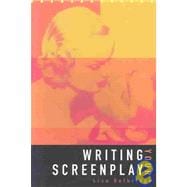
Note: Supplemental materials are not guaranteed with Rental or Used book purchases.
Purchase Benefits
Looking to rent a book? Rent Writing Your Screenplay [ISBN: 9781741140835] for the semester, quarter, and short term or search our site for other textbooks by Dethridge, Lisa. Renting a textbook can save you up to 90% from the cost of buying.
| Introduction | 1 | (13) | |||
|
1 | (6) | |||
|
7 | (3) | |||
|
10 | (4) | |||
| Chapter 1: Cinema creates a parallel universe | 14 | (26) | |||
|
16 | (2) | |||
|
18 | (1) | |||
|
19 | (2) | |||
|
21 | (2) | |||
|
23 | (2) | |||
|
25 | (2) | |||
|
27 | (2) | |||
|
29 | (1) | |||
|
29 | (3) | |||
|
32 | (2) | |||
|
34 | (1) | |||
|
35 | (3) | |||
|
38 | (2) | |||
| Chapter 2: Know the rules before you break them | 40 | (17) | |||
|
41 | (6) | |||
|
47 | (7) | |||
|
54 | (1) | |||
|
55 | (2) | |||
| Chapter 3: The psychology of the protagonist | 57 | (19) | |||
|
58 | (1) | |||
|
59 | (1) | |||
|
60 | (2) | |||
|
62 | (4) | |||
|
66 | (1) | |||
|
67 | (1) | |||
|
68 | (1) | |||
|
69 | (3) | |||
|
72 | (2) | |||
|
74 | (2) | |||
| Chapter 4: Time is the basic building block | 76 | (20) | |||
|
77 | (1) | |||
|
78 | (3) | |||
|
81 | (1) | |||
|
82 | (2) | |||
|
84 | (3) | |||
|
87 | (5) | |||
|
92 | (3) | |||
|
95 | (1) | |||
| Chapter 5: Devices for manipulating story chronology | 96 | (25) | |||
|
98 | (1) | |||
|
98 | (7) | |||
|
105 | (4) | |||
|
109 | (3) | |||
|
112 | (1) | |||
|
113 | (7) | |||
|
120 | (1) | |||
| Chapter 6: Your premise governs three acts | 121 | (26) | |||
|
122 | (2) | |||
|
124 | (3) | |||
|
127 | (1) | |||
|
128 | (2) | |||
|
130 | (6) | |||
|
136 | (8) | |||
|
144 | (3) | |||
| Chapter 7: Scene construction | 147 | (10) | |||
|
147 | (3) | |||
|
150 | (2) | |||
|
152 | (1) | |||
|
152 | (1) | |||
|
153 | (2) | |||
|
155 | (1) | |||
|
156 | (1) | |||
| Chapter 8: Dialogue and characterisation | 157 | (12) | |||
|
157 | (1) | |||
|
158 | (4) | |||
|
162 | (1) | |||
|
163 | (5) | |||
|
168 | (1) | |||
| Chapter 9: Plotlines, subplots and secondary characters | 169 | (20) | |||
|
169 | (3) | |||
|
172 | (1) | |||
|
173 | (3) | |||
|
176 | (1) | |||
|
177 | (2) | |||
|
179 | (2) | |||
|
181 | (6) | |||
|
187 | (2) | |||
| Chapter 10: Act one structure | 189 | (11) | |||
|
190 | (2) | |||
|
192 | (1) | |||
|
193 | (1) | |||
|
194 | (1) | |||
|
195 | (2) | |||
|
197 | (3) | |||
| Chapter 11: Act two structure | 200 | (13) | |||
|
200 | (2) | |||
|
202 | (6) | |||
|
208 | (3) | |||
|
211 | (2) | |||
| Chapter 12: Act three structure | 213 | (16) | |||
|
214 | (1) | |||
|
215 | (6) | |||
|
221 | (6) | |||
|
227 | (2) | |||
| Chapter 13: Fleshing out your screenplay | 229 | (12) | |||
|
229 | (1) | |||
|
230 | (6) | |||
|
236 | (1) | |||
|
237 | (3) | |||
|
240 | (1) | |||
| References and recommended reading | 241 | (2) | |||
| Filmography | 243 | (5) | |||
| Index | 248 |
The New copy of this book will include any supplemental materials advertised. Please check the title of the book to determine if it should include any access cards, study guides, lab manuals, CDs, etc.
The Used, Rental and eBook copies of this book are not guaranteed to include any supplemental materials. Typically, only the book itself is included. This is true even if the title states it includes any access cards, study guides, lab manuals, CDs, etc.